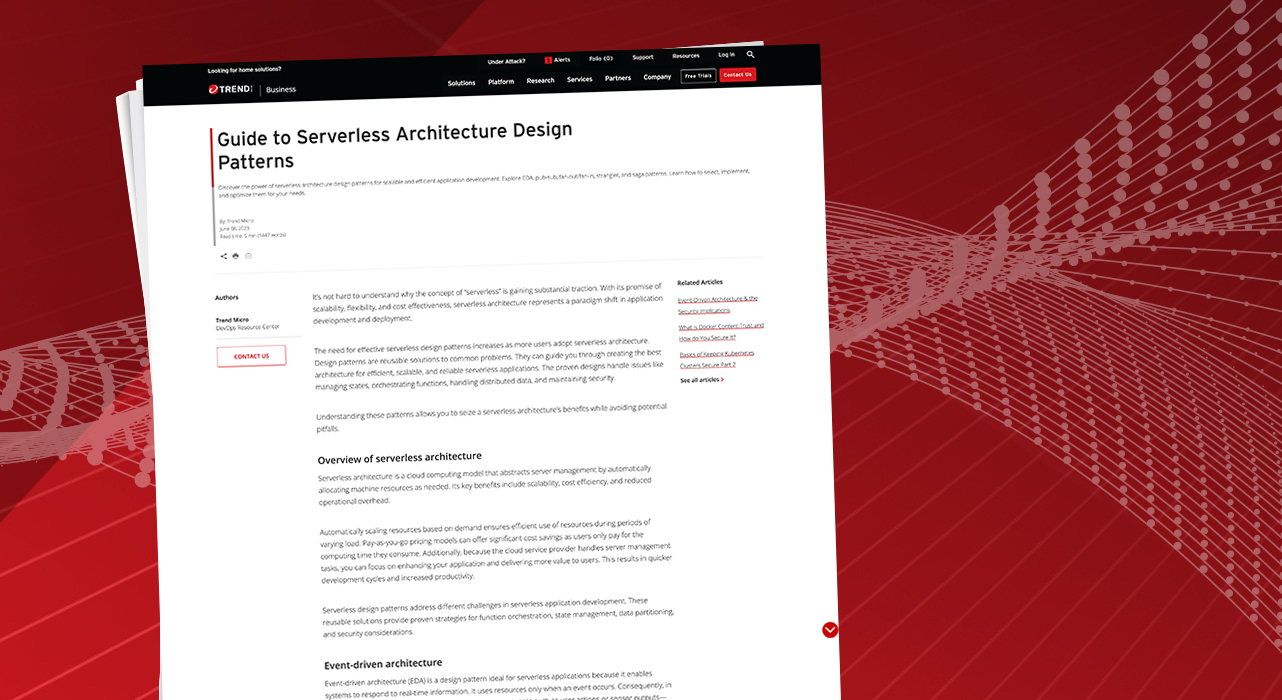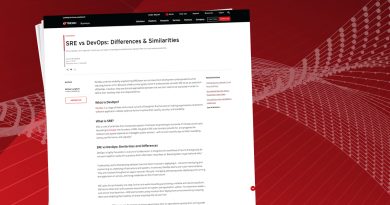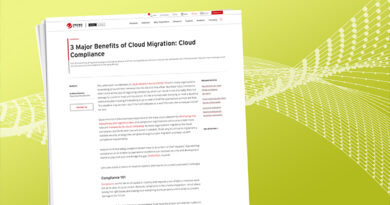Guide to Serverless Architecture Design Patterns


It’s not hard to understand why the concept of “serverless” is gaining substantial traction. With its promise of scalability, flexibility, and cost effectiveness, serverless architecture represents a paradigm shift in application development and deployment.
The need for effective serverless design patterns increases as more users adopt serverless architecture. Design patterns are reusable solutions to common problems. They can guide you through creating the best architecture for efficient, scalable, and reliable serverless applications. The proven designs handle issues like managing states, orchestrating functions, handling distributed data, and maintaining security.
Understanding these patterns allows you to seize a serverless architecture’s benefits while avoiding potential pitfalls.
Overview of serverless architecture
Serverless architecture is a cloud computing model that abstracts server management by automatically allocating machine resources as needed. Its key benefits include scalability, cost efficiency, and reduced operational overhead.
Automatically scaling resources based on demand ensures efficient use of resources during periods of varying load. Pay-as-you-go pricing models can offer significant cost savings as users only pay for the computing time they consume. Additionally, because the cloud service provider handles server management tasks, you can focus on enhancing your application and delivering more value to users. This results in quicker development cycles and increased productivity.
Serverless design patterns address different challenges in serverless application development. These reusable solutions provide proven strategies for function orchestration, state management, data partitioning, and security considerations.
Event-driven architecture
Event-driven architecture (EDA) is a design pattern ideal for serverless applications because it enables systems to respond to real-time information. It uses resources only when an event occurs. Consequently, in serverless environments—where functions must react to events such as user actions or sensor outputs—EDA enables extensive scalability and efficiency.
EDA processes each event independently. Events trigger real-time responses by instantly invoking the associated function, making EDA ideal for applications needing immediate action. Additionally, its decoupled components make the system flexible and maintainable. As a result, EDA is useful in diverse areas like the Internet of things (IoT), real-time data processing, and notification systems. EDA processes IoT devices that constantly generate sensor data most efficiently. For example, financial applications can process and react to stock price changes in real time or send thousands of notifications in response to important events.
Pub-sub pattern
The publish-subscribe (pub-sub) pattern is a messaging model for serverless architectures that decouples event publishers from subscribers. In a pub-sub system, publishers create events and send them to a message broker without knowing who the subscribers are. In turn, subscribers receive events they’ve subscribed to without knowledge of the publishers. A message broker routes messages from publishers to the appropriate subscribers.
Decoupling allows breaking tasks into smaller, independently manageable parts, enhancing flexibility and reliability. For instance, you can add or remove subscribers without impacting publishers. Additionally, if sending a message to a subscriber fails, the message broker can retry delivery. Therefore, the pub-sub pattern is useful in messaging systems such as chat applications, where multiple subscribers must receive the same message. Pub-sub also aids in event sourcing, notifying relevant system parts when a new event occurs. Furthermore, it increases efficiency for applications requiring real-time updates, such as stock market applications or live sports updates.
The pub-sub pattern uses a high level of decoupling compared to the other design patterns. It relies purely on a subscriber-based system, rather than the more complex and interactive processes associated with EDA. While pub-sub enables simple one-to-many communication through a publisher-subscriber setup, EDA provides more flexibility with real-time, event-based processing.
Fan-out/fan-in pattern
The fan-out/fan-in design pattern is a strategy for serverless applications enabling efficient parallel processing and aggregation. It’s ideal for performing operations independently on different data segments. This pattern divides the input into independent subtasks, significantly accelerating execution time for large tasks. The system creates more function instances as the workload increases, leading to excellent demand-based scalability, better resource use, and enhanced cost efficiency.
The fan-out/fan-in pattern is best for data processing pipelines, batch processing, and distributed computing. In data processing, it breaks down large volumes of data into smaller chunks for parallel processing. Therefore, it enables the simultaneous processing of multiple images or video frames and reduces total processing time. In distributed computing tasks like Monte Carlo simulations or genetic algorithms, computations occur in multiple function instances for faster results.
The fan-out/fan-in pattern’s unique strength is its ability to break tasks into independent subtasks for more efficient handling. While other patterns—like pub-sub or EDA—also support parallel processing to some degree, they provide less support for aggregating results from multiple function instances into a single output. However, EDA demonstrates similar scalability and adds the benefit of real-time processing. Comparatively, fan-out/fan-in primarily involves scaling computational resources and consolidating results and lacks EDA’s responsiveness to individual events.
Strangler pattern
The strangler pattern is a design for migrating legacy systems to serverless architectures. In this pattern, you incrementally build serverless components around an existing system, each handling specific requests or functions. As you add serverless components, you gradually phase out the old system, allowing a non-disruptive refactoring process. You can employ the strangler pattern to gradually introduce new features or improvements, testing and refining them before replacing the corresponding legacy components.
Using this pattern reduces risk and facilitates a smooth transition. It’s especially beneficial for organizations with large monolithic applications, where a complete rewrite to serverless may be time-consuming and risky.
The strangler pattern is specifically for application migration and modernization purposes. It provides a more systematic approach to transforming existing systems into serverless architectures than any other pattern. Conversely, patterns like EDA, pub-sub, or fan-out/fan-in are for building systems with specific characteristics—like parallel processing, decoupling, and real-time data processing.
Saga pattern
The saga pattern, or the saga interaction pattern, is a design in serverless architectures to manage complex, distributed transactions. It’s ideal when a sequence of local transactions collectively form a global transaction and data consistency across these transactions is crucial, especially with potential partial failures.
This pattern divides a significant global transaction into smaller, related local transactions. Each local transaction updates data in a specific service and signals its completion. If all local transactions succeed, the global transaction is successful. However, if a local transaction fails, it executes compensating transactions or rollbacks to maintain data consistency.
The saga pattern is more beneficial than other patterns when a business process involves multiple steps or services. For example, in an e-commerce application, an order may include inventory reduction, payment processing, and shipping. If payment fails, the system must reverse the inventory reduction. Similarly, in a travel booking system involving flight bookings, hotel reservations, and car rentals, failure at any step cancels the entire transaction and the saga pattern executes compensating transactions to maintain consistency.
With the exception of EDA, other patterns can’t do this. However, although the saga pattern and EDA both provide decoupling and independent scalability, saga focuses on ensuring consistency in distributed systems while EDA focuses on real-time event-based operations.
Best practices for implementing serverless design patterns
Adhering to best practices is critical for successful application deployment when working with serverless design patterns. These practices involve picking the best design pattern based on your application’s needs and constraints, combining multiple patterns when necessary, and regularly monitoring and optimizing your serverless applications. Analyzing factors—such as scalability requirements, the degree of decoupling needed, the type of data to process, and the presence of distributed transactions—guides you to the most suitable design pattern.
For complex applications, you might need more than a single design pattern. Combining multiple patterns—like using pub-sub for decoupling, fan-out/fan-in for parallel processing, and saga for distributed transactions—can provide the best solution.
Monitoring your serverless applications is also vital for optimal performance and cost efficiency. Keep track of performance metrics such as response times, error rates, and resource use. Additionally, analyze usage patterns to optimize resource allocation and lower costs. This analysis could involve adjusting your serverless functions’ concurrency settings, memory allocation, or timeout values. Furthermore, regularly reviewing and updating your application’s architecture improves efficiency and maintainability.
Conclusion
In the fast-paced world of modern application development, serverless architecture has emerged as a popular choice due to its scalability, cost efficiency, and reduced operational overhead.
This article introduced several important serverless design patterns, each with unique advantages. Serverless design patterns offer powerful strategies for tackling common challenges in serverless application development. Their solutions are scalable, efficient, and robust.
However, choosing the most appropriate design pattern—or a combination of patterns—depends on your specific application requirements. Remember, implementing serverless design patterns is just the beginning. Monitoring and optimizing your serverless applications for performance and cost efficiency is an ongoing process that ensures the long-term success of your applications.
Read More HERE



